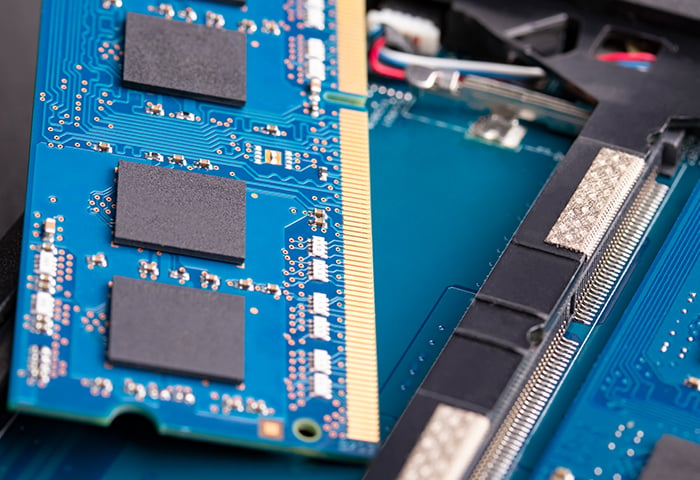How can I boost my Wi-Fi signal at home?
If you’re having difficulty using your Wi-Fi network in all areas of your home, you can fix a weak Wi-Fi signal with a mixture of hardware and software solutions. Wi-Fi repeaters can extend your router’s range, while software updates can ensure you’re using the most current technology.
We’ve collected 10 ways for you to boost your home Wi-Fi signal — first by adjusting your router’s location and tweaking your settings, and then with a few hardware upgrades. Before you start, benchmark your Wi-Fi signal to evaluate its current performance. Then, check it again after making a modification to see if you’ve managed to improve your Wi-Fi signal.
Here’s how to make your Wi-Fi signal stronger at home:
Optimize your router placement
One of the best ways to boost your Wi-Fi signal at home is to reposition your router to a more central location. This helps your router provide Wi-Fi coverage to as much of your home as possible, while avoiding Wi-Fi blockers like thick walls, doors, and electrical interference from household appliances.
While you can experiment with router placement using the trial-and-error method, it’s easier and faster to use a home network mapping tool like Heatmapper (premium only). You can use the tool to analyze your home layout and find out where your Wi-Fi signal is strongest and weakest.
%20-%20refresh/img_01.png?width=1500&name=img_01.png) The Heatmapper tool for Windows helps to boost your Wi-Fi signal at home by showing you where to place your router for best results.
The Heatmapper tool for Windows helps to boost your Wi-Fi signal at home by showing you where to place your router for best results.
The best place for your router will generally be in the center of your home, possibly in a corridor, and away from any thick walls or doors.
Update your router firmware
Your router’s firmware can quickly become outdated if you aren’t updating it regularly. In addition to helping boost your Wi-Fi signal, updating your router’s firmware can also prevent router hacks — many types of router malware are built to exploit vulnerabilities in older firmware.
To update your router’s firmware, visit your router manufacturer’s website and download the most current software. You may be able to find a firmware update option in your router’s admin menu, but these don’t often show the most current information. To ensure you get the most current firmware, go to the manufacturer’s website instead.
%20-%20refresh/img_02.png?width=1500&name=img_02.png) The Netgear Download Center offers firmware downloads and other software for Netgear routers.
The Netgear Download Center offers firmware downloads and other software for Netgear routers.
If your router was provided by your internet service provider (ISP), you may not be able to update the firmware yourself — they may do it automatically. Contact your ISP to confirm.
Switch your router to 5 GHz
Your router’s settings should allow you to choose between 2.4 GHz, 5 GHz, or both. A 5 GHz network is faster than a 2.4 GHz network, but 2.4 GHz is better at penetrating through obstacles. While 6 GHz is now available, it’s not yet in widespread home use.
You need to log into your router’s admin menu to enable 5 GHz. To do that, you need your router’s IP address. Your router’s IP address may be written somewhere on your router. If not, you have two options for finding it.
First option: Find your router’s IP address using the Command Prompt
-
Type cmd into the Windows search box or Start menu and press Enter. Open the Command Prompt.
%20-%20refresh/img_03.png?width=600&name=img_03.png)
-
Enter the command ipconfig and press Enter. Scroll down and locate Default Gateway to find your router’s IP address.
%20-%20refresh/img_04.png?width=650&name=img_04.png)
Second option: Find your router’s IP address in your Windows settings
-
Click the Settings cog in the Start menu to open your settings.
%20-%20refresh/img_05.png?width=600&name=img_05.png)
-
Click Network & Internet.
%20-%20refresh/img_06.png?width=1098&name=img_06.png)
-
In the Status menu, click View hardware and connection properties.
%20-%20refresh/img_07.png?width=600&name=img_07.png)
-
The Default gateway entry is your router’s IP address.
%20-%20refresh/img_08.png?width=600&name=img_08.png)
Whichever method you use, copy your router’s IP address — you’ll need it to log into your router’s menu.
Log into your router’s menu and enable 5 GHz and 2.4 Ghz
Enable both 5 GHz and 2.4 GHz so that you’ll get optimum coverage no matter where in your home you are. Here’s how to enable 5 GHz on your router to boost your Wi-Fi signal:
-
Log into your router menu. Enter your router’s IP address into your browser, press Enter, and type in your username and password to log in.
-
Find your wireless settings options.
-
Change your settings to 5 GHz, or enable both 5 GHz and 2.4 GHz (recommended).
%20-%20refresh/img_09.png?width=600&name=img_09.png)
Configuring router settings to 5 GHz and 2.4 GHz to help boost your Wi-Fi.
Some routers allow you to create separate 5 GHz and 2.4 GHz networks. By doing so, you'll ensure that your 5 GHz–capable devices are all using the faster network.
Tweak your router’s CTS/RTS threshold, fragmentation threshold, and other settings
Your router may let you optimize other settings to boost your Wi-Fi signal. Look through your settings for the following:
-
CTS/RTS Threshold: CTS means “clear to send” and RTS means "request to send." These ask devices on a network for permission to send the next data packet. Lower CTS thresholds or RTS thresholds make for more stable Wi-Fi networks.
If your Wi-Fi network is stable, set the CTS or RTS Threshold to the maximum allowed — usually 2347. If your Wi-Fi signal often drops out, or if you need to frequently restart your router, try lowering this value.
%20-%20refresh/img_10.png?width=600&name=img_10.png)
-
Fragmentation Threshold: This sets the maximum size for each data packet. Smaller packets improve reliability, but at the cost of lowered performance. Keep this at the default (usually 2346) unless your Wi-Fi network is highly unstable.
Change your Wi-Fi channel
Your router can broadcast your Wi-Fi signal on a range of channels. If you’re using the same Wi-Fi channel as other networks around you, your network performance can suffer. You can use a built-in Windows tool to check which channels are in use around you, then pick a less-crowded one for your network to boost your Wi-Fi signal at home.
-
Open the Command Prompt by typing cmd into the Start menu or the Windows search box. Then, enter the following command into the Command Prompt:
netsh wlan show all
%20-%20refresh/img_11.png?width=613&name=img_11.png)
-
You’ll see a large list of wireless networks in your area. Each network listing will include an entry called Channel — this tells you which Wi-Fi channel that network is using. In this example, the network is using channel 5.
%20-%20refresh/img_12.png?width=520&name=img_12.png)
-
Note the channels in use around you, so you know which ones not to use. Then, log into your router menu and find your wireless channel settings.
%20-%20refresh/img_13.png?width=500&name=img_13.png)
-
Pick a channel for your router that isn’t being used by the networks detected in Step 2. If all the channels are currently in use, try and pick one that is only used by a few of the networks you found. Save your changes to boost your Wi-Fi signal with a new channel.
Update your computer’s Wi-Fi driver
Drivers are a special type of software that tell a piece of hardware — like your computer’s Wi-Fi adapter — how to function. Outdated drivers can cause all sorts of problems, and an outdated wireless driver may be exactly what’s needed to increase your Wi-Fi speed.
How to manually update your Wi-Fi driver
To update your driver manually, open the Device Manager on your Windows computer and look for your wireless adapter. Our test laptop features an Intel Dual Band Wireless-AC 8625 adapter.
%20-%20refresh/img_14.png?width=600&name=img_14.png)
After identifying your adapter, visit the manufacturer’s website to look for new drivers. You can download and install the latest drivers for your wireless adapter directly from the manufacturer.
%20-%20refresh/img_15.png?width=600&name=img_15.png)
How to automatically update your Wi-Fi driver
Manually identifying your hardware and finding the appropriate drivers is time-consuming. For optimal performance, you need to regularly update the drivers in your PC, including updating your audio drivers and getting new graphics drivers.
AVG Driver Updater will automatically source and install the latest drivers for all your hardware. You’ll never need to worry about outdated wireless drivers, or any others. It’s one of the best ways to boost your Wi-Fi signal on your laptop or desktop PC.
Add an external router antenna
Adding an external antenna to your router can be a great way to boost your Wi-Fi signal to your laptop, desktop, or mobile device at home. If you can’t replace your router’s antenna, you can add an external one instead.
Check your router’s user manual and website for information regarding antenna upgrades. You’ll want to choose an antenna with a higher amount of gain (measured in dBi) than your current antenna.
Some routers feature removable antennas, and you can simply swap out the stock antennas for new ones. If not, you’ll need to modify your router. This is an advanced procedure that may require some serious rebuilding of your router. Try this only if you’re confident in your abilities.
Use a Wi-Fi repeater
A Wi-Fi repeater — also called a Wi-Fi booster or a Wi-Fi extender — is a small device that can extend the range of your Wi-Fi network. A Wi-Fi repeater placed near the edge of your coverage area can quickly boost your Wi-Fi signal.
Use a Wi-Fi network mapping tool (described earlier) to find a weak spot in your network and install the Wi-Fi repeater there. Make sure the repeater will still receive at least 80% of the original signal strength.
It just takes a few minutes to set up a Wi-Fi repeater. Simply plug it in, follow the manufacturer’s instructions, and it should boost your Wi-Fi signal at home.
Use a USB wireless adapter
Even if your computer’s built-in wireless adapter supports the latest Wi-Fi technology, you may be able to boost your Wi-Fi signal with a USB adapter instead. Your chances will be even higher if you choose a USB adapter recommended by your router’s manufacturer — some adapters work better with certain routers over others.
%20-%20refresh/img_16.png?width=1117&name=img_16.png) A USB wireless adapter boosted our Wi-Fi signal from 130 Mbps all the way up to 300 Mbps.
A USB wireless adapter boosted our Wi-Fi signal from 130 Mbps all the way up to 300 Mbps.
Upgrade your router
Older wireless adapters and routers may struggle to provide enough bandwidth for modern streaming applications and online gaming. Newer Wi-Fi standards have been introduced that allow for higher maximum bandwidths.
The newest standard is 802.11ax, but it isn’t yet widely available. Most newer desktops, laptops, and mobile devices will support the 802.11ac standard. If your router doesn’t, you’ll be forced to use a slower Wi-Fi network.
Here’s how to check your router’s Wi-Fi standard and boost your Wi-Fi signal with 802.11ac:
-
Log into your router’s admin menu.
-
Find your wireless settings.
-
Locate your 802.11 network options.
%20-%20refresh/img_17.png?width=500&name=img_17.png)
If you already have 802.11ac available, you don’t need to upgrade your router. Otherwise, look for a router with the following features:
-
Support for 5 GHz networks and the 802.11ac Wi-Fi standard.
-
Replaceable antennas.
-
Extended features such as MU-MIMU and Quality of Service.
-
Optional guest networks, which can protect your devices from malware and hacking.
Benchmark your Wi-Fi network after making a change
Test your Wi-Fi network after trying each of the suggestions listed above to see whether or not you’ve succeeded in boosting your Wi-Fi signal. LAN Speed Test Lite, Lanbench, Netstress, and Speedtest are four benchmarking tools that measure the response time, throughput, and streaming performance of your wireless setup.
Depending on the test, you may need to enter IP addresses from two devices.
%20-%20refresh/img_18.png?width=600&name=img_18.png) Test your network before and after boosting your Wi-Fi.
Test your network before and after boosting your Wi-Fi.
Why is my Wi-Fi signal weak?
Many factors can cause a weak Wi-Fi signal, from physical obstacles like walls and doors to signal interference or router issues. That’s why boosting your Wi-Fi signal involves a lot more than moving closer to your router.
Here are a few reasons why your Wi-Fi signal is weak at home:
-
You’re too far from your router. Wi-Fi routers are local devices, and they don’t cover that much distance. If you have a large home, some areas may be outside your router’s transmission range.
-
Your Wi-Fi signal is blocked. Wi-Fi signals can struggle to penetrate walls, doors, and other physical obstacles in your home. It can be difficult for the frequencies used by your router to break through these Wi-Fi blockers.
-
There’s interference with your Wi-Fi signal. We’re surrounded by radio waves from mobile phones, smart devices, car radios, and more. Household appliances, such as refrigerators and washing machines, can also interfere with your Wi-Fi signal. And if you’re living in an apartment building, other nearby Wi-Fi networks can mess with yours.
-
You’re consuming too much bandwidth. If you or someone else on your network is sucking up all the bandwidth via P2P torrents, large downloads, streaming movies, watching TV online, or streaming games like GTA V on Twitch, it can leave little for anyone else.
-
Your router isn’t strong enough. Cheaper or older routers can’t support high levels of traffic to many devices at once. Your router may struggle to provide a strong Wi-Fi signal to all the devices on your network.
-
There’s an issue with your internet connection. Wi-Fi troubles might not be due to your router. Try connecting with an Ethernet cable, then perform an internet speed test. If your results show a slower internet speed than you’re paying for, it’s time to contact your ISP. Slow speeds may also be the result of internet throttling.
Automatically boost your Wi-Fi signal with updated drivers
While many of the tips in this article require a bit of manual labor, there’s one thing you can do right now to automatically boost your Wi-Fi signal and optimize your PC across the board. Updating your drivers ensures that your PC will always have the most current software available — helping you evade exploit-based hacks and making sure you get top performance.
AVG Driver Updater automatically sources, downloads, and installs current drivers from over 1,300 major hardware brands. With over 8 million drivers in its database, it has all the drivers you need to keep your PC in optimal condition.

%20-%20refresh/img_01.png?width=1500&name=img_01.png) The Heatmapper tool for Windows helps to boost your Wi-Fi signal at home by showing you where to place your router for best results.
The Heatmapper tool for Windows helps to boost your Wi-Fi signal at home by showing you where to place your router for best results.%20-%20refresh/img_02.png?width=1500&name=img_02.png) The Netgear Download Center offers firmware downloads and other software for Netgear routers.
The Netgear Download Center offers firmware downloads and other software for Netgear routers.%20-%20refresh/img_03.png?width=600&name=img_03.png)
%20-%20refresh/img_04.png?width=650&name=img_04.png)
%20-%20refresh/img_05.png?width=600&name=img_05.png)
%20-%20refresh/img_06.png?width=1098&name=img_06.png)
%20-%20refresh/img_07.png?width=600&name=img_07.png)
%20-%20refresh/img_08.png?width=600&name=img_08.png)
%20-%20refresh/img_09.png?width=600&name=img_09.png)
%20-%20refresh/img_10.png?width=600&name=img_10.png)
%20-%20refresh/img_11.png?width=613&name=img_11.png)
%20-%20refresh/img_12.png?width=520&name=img_12.png)
%20-%20refresh/img_13.png?width=500&name=img_13.png)
%20-%20refresh/img_14.png?width=600&name=img_14.png)
%20-%20refresh/img_15.png?width=600&name=img_15.png)
%20-%20refresh/img_16.png?width=1117&name=img_16.png) A USB wireless adapter boosted our Wi-Fi signal from 130 Mbps all the way up to 300 Mbps.
A USB wireless adapter boosted our Wi-Fi signal from 130 Mbps all the way up to 300 Mbps.%20-%20refresh/img_17.png?width=500&name=img_17.png)
%20-%20refresh/img_18.png?width=600&name=img_18.png) Test your network before and after boosting your Wi-Fi.
Test your network before and after boosting your Wi-Fi.













